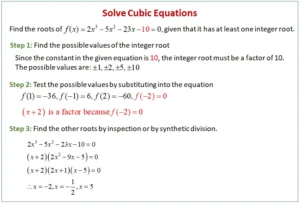Today, we’re going to learn How to Solve a Cubic Equation. Don’t worry if that sounds a bit tricky, this guide is here to show you easy steps to figure out these cool math puzzles. Whether you’re studying for class or just curious about numbers, let’s crack the code of cubic equations together!
What is a Cubic Equation?
A cubic equation is a math problem that includes x3x^3×3, which means xxx multiplied by itself three times. It looks like this: ax3+bx2+cx+d=0ax³ + bx² + cx + d = 0ax3+bx2+cx+d=0, where aaa, bbb, ccc, and ddd are numbers, and aaa is not zero. These equations might look tough, but they are not too hard once you know how to handle them.
Getting Ready to Solve: Important Ideas
Before we start solving these equations, we need to understand a few basic things. This will help us know what to do and why.
Polynomials and Their Graphs
Polynomials are math expressions with xxx raised to different powers, added together. A cubic equation is one kind of polynomial. When you draw it, it looks like a wavy line that can cross the line where you measure xxx up to three times. Knowing this shape helps you guess where the answers to the equation might be.
Roots and Solutions
The roots of a polynomial are the answers you get for xxx that make the equation equal zero. In simpler words, they are where the wavy line crosses the xxx-line. A cubic equation can have one, two, or three spots where it crosses the xxx-line, and these spots are our answers.
Complex Numbers in Cubic Equations
Sometimes, the answers to these equations aren’t just regular numbers; they can be complex numbers. A complex number is made up of a regular number and an imaginary number (like the square root of a negative number). Even though they sound strange, these complex numbers are very useful in finding solutions when regular numbers don’t work.

How to Solve a Cubic Equation
Solving cubic equations might seem tough, but there are many ways to do it. Some methods are simple, while others might need a few extra steps or even a calculator.
-
Factoring
Factoring means breaking the equation into smaller parts that are easier to solve.
- When one root is obvious: Sometimes, you can quickly find a number that solves the equation. For example, if putting x=1x = 1x=1 makes the equation turn into zero, then x−1x – 1x−1 is one part of the solution.
- Grouping method: You can also solve the equation by grouping terms together. This means you arrange the equation so that parts of it share something common, and that makes it easier to solve.
-
Cardano’s Formula
This is a special rule that can solve any cubic equation, even really complicated ones.
- History of Cardano’s method: A long time ago, a mathematician named Gerolamo Cardano came up with this formula. It was a big discovery because it helped people solve tricky cubic equations for the first time.
- Step-by-step breakdown: To use this formula, you need to change the equation a little bit and then use the formula to find the answers. It’s just like using a recipe to make your favorite cake!
-
Trigonometric Solution
This method uses trigonometry, which is a part of math that studies angles and triangles, to find the answers.
- Viète’s trigonometric substitution: This technique was named after a mathematician named François Viète. It involves replacing parts of the equation with trigonometry terms to make it easier to solve.
- When to use this method: This method works best if the equation has three real answers and can be changed into a form that looks like a trigonometry problem. It’s like using angles to find your answers!
-
Numerical Methods
If the equation is too hard to solve by hand, we can use methods that involve calculations done by computers.
- Newton-Raphson method: This method starts with a guess and then uses a special part of math called calculus to make the guess better. It’s a powerful way to find answers that are hard to get otherwise.
- Halley’s method: This is similar to the Newton-Raphson method but uses an even better formula to make guesses more quickly. It finds the answers faster and with fewer steps.
Conclusion
We’ve learned a lot about How to Solve a Cubic Equation. Now, you have many tools to help you solve these tricky math problems. Whether you break the equation into smaller parts, use Cardano’s special rule, solve it with angles, or try a computer method, you can find the right way that works for you.
Practice makes perfect! The more you try solving these equations, the easier it will become. And if it seems hard at first, don’t worry. Everyone starts from the beginning, even the best mathematicians!
Need more help or want to learn other cool math tricks? Check out our website at Allassignmenthelp.org. We have lots of tips and guides to help you with your homework and make learning fun. We’re here to help you get better at math and feel confident in solving cubic equations.
Keep practicing and always be curious. And remember, if you ever need a helping hand with your math, just visit us at Allassignmenthelp.org. Let’s solve those cubic equations together and have fun doing it!
Read more:
How to Solve the Math Equation
How to Solve a Variable Equation
FAQs about Cubic Equations
How many answers can a cubic equation have?
A cubic equation can have up to three solutions. These could be all real numbers or a mix of real and imaginary ones. It depends on how the equation is structured.
Can the quadratic formula be used for cubic equations?
No, the quadratic formula works only for equations with x² as the highest term. Cubic equations involve x³, so they need different solving methods. Trying the wrong formula won’t give the correct answers.
What are imaginary numbers and why do they matter in cubics?
Imaginary numbers help solve equations when real numbers don’t work. They use the square root of negative numbers, like √–1. This makes it possible to find all answers, even hidden ones.









